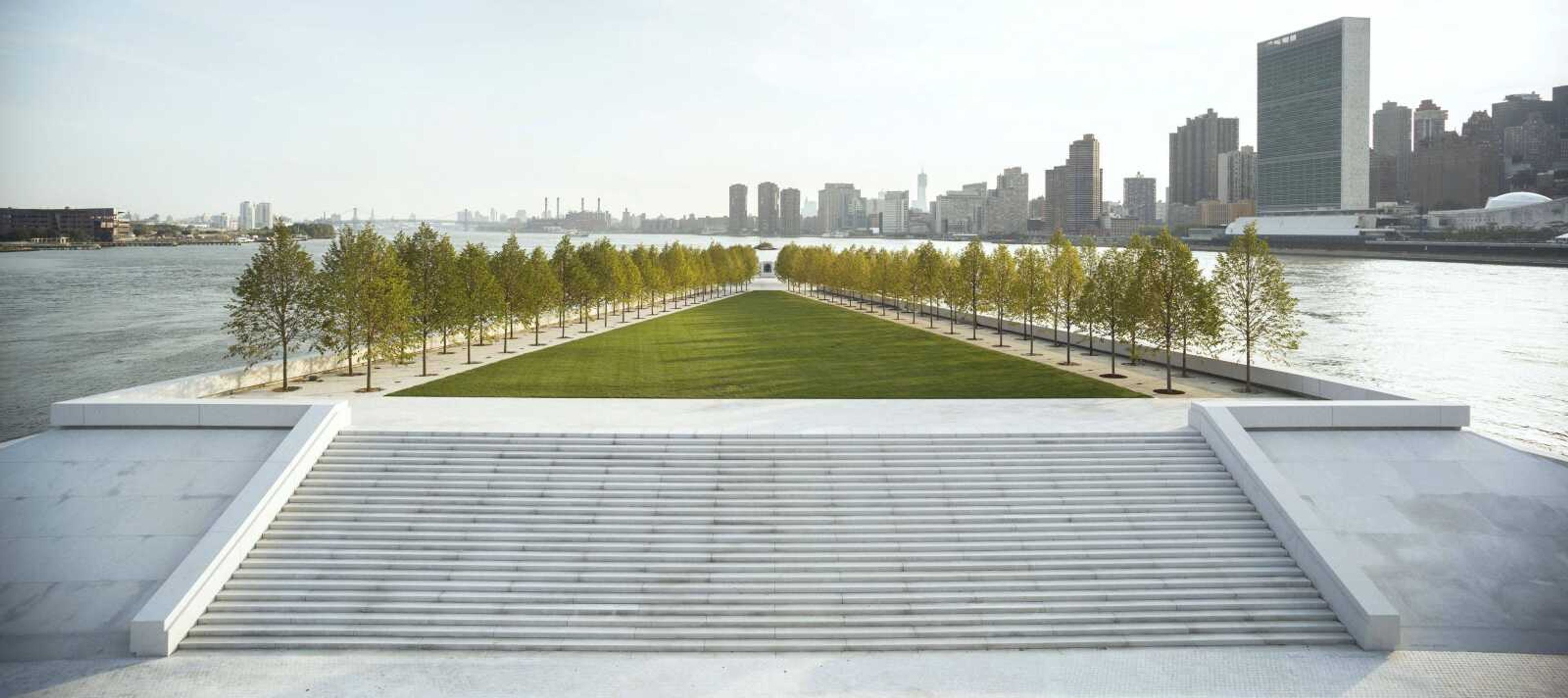Decades late, FDR park dedicated in N.Y.
NEW YORK -- Celebrating a design 40 years in the making, dignitaries Wednesday dedicated a new memorial park to President Franklin Roosevelt overlooking the United Nations that he helped found. The Franklin D. Roosevelt Four Freedoms Park, on an island in the East River, "will stand forever as a monument to the man who brought us through the Great Depression and brought us victory over great evil," Mayor Michael Bloomberg told several hundred people at the dedication ceremony...
NEW YORK -- Celebrating a design 40 years in the making, dignitaries Wednesday dedicated a new memorial park to President Franklin Roosevelt overlooking the United Nations that he helped found.
The Franklin D. Roosevelt Four Freedoms Park, on an island in the East River, "will stand forever as a monument to the man who brought us through the Great Depression and brought us victory over great evil," Mayor Michael Bloomberg told several hundred people at the dedication ceremony.
Former President Bill Clinton said that Roosevelt's dream for a better world "is still the right dream for America," and the park should remind the nation that FDR's lofty goals are worth pursuing.
The triangular park is named after Roosevelt's 1941 State of the Union address, known as the Four Freedoms Speech. Given before America got involved in World War II, Roosevelt said the way to justify the enormous sacrifice of war was to create a world centered on four essential human freedoms: freedom of speech and expression; freedom of worship; freedom from want; and freedom from fear. The words were later incorporated into the charter of the United Nations.
The park sits on Roosevelt Island, a 2-mile slice of land between Manhattan and Queens. The 4-acre triangular expanse of green is flanked by 120 trees leading to a colossal bronze bust of Roosevelt at the threshold of a white granite open-air plaza.
The statue is an enlargement of a 28-inch bust of Roosevelt, also a New York governor, created by American sculptor Jo Davidson. It sits in a stone niche on the back of which a passage from the Four Freedoms speech is carved. The statue sits a mere 300 yards across the river from the United Nations headquarters.
The park will open to the public once arrangements for its operation and maintenance are final, officials said.
"We hope visitors of different ages will understand that the four freedoms are the core values of democracy and that each generation has to be sure to protect them," said former U.S. Ambassador to the U.N. William vanden Heuvel, chairman of the Franklin D. Roosevelt Four Freedoms Park LLC.
Gov. Nelson Rockefeller and Mayor John Lindsay first announced creation of the memorial park and appointed Louis Kahn as its architect in 1973. Vanden Heuvel, who was there that day, said Kahn completed the drawings a year later. That same year, Rockefeller became vice president, and the city verged on bankruptcy. With no money, the park was shelved.
"It is altogether fitting that this day was delayed until a time when we knew that we could never take the Four Freedoms for granted -- in a time when we too would have to decide whether to build a country that benefits the many and not just the few," Clinton said.
The project was revived by vanden Heuvel in 2005 after the Oscar-nominated documentary about Kahn, "My Architect," brought renewed interest to the memorial.
Over the next seven years, $53 million was raised, $34 million from private donors. The rest came from the city and the state.
The park had been embroiled in a legal dispute with two of its major donors over how prominently their names would be displayed at the site. The Alphawood Foundation, which donated $10.8 million, reached an undisclosed settlement, while the Reed Foundation, which gave $2.9 million, won a court judgment for its name to be engraved in an area near the memorial bust as spelled out in a contract. The park had argued that "such a placement would dishonor a great president and defile Kahn's great work."
A sculpture highlighting Roosevelt's disability is planned for the future. Roosevelt was stricken with polio at the age of 39 and needed a wheelchair for the rest of his life. The statue by sculptor Meredith Bergmann will depict him seated in a wheelchair, reaching for the hand of a young girl on crutches.
Nancy Brown, 70, who got polio at age 7 and attended the ceremony in a wheelchair, said the sculpture will be "an inspiration to people who are disabled, especially children." She said it will make "them feel they can do anything."
In the next several years, the park hopes to transform a nearby abandoned hospital into a visitor's center. About 15,000 people live on the northern end of the island, which is reachable by tram or subway. The park plans to work closely with Cornell University, which is planning a graduate center on the island, on a nearby dock to transport people via water taxi and ferry.
------
Associated Press writer Samantha Gross contributed to the report.
------
Online:
Connect with the Southeast Missourian Newsroom:
For corrections to this story or other insights for the editor, click here. To submit a letter to the editor, click here. To learn about the Southeast Missourian’s AI Policy, click here.









